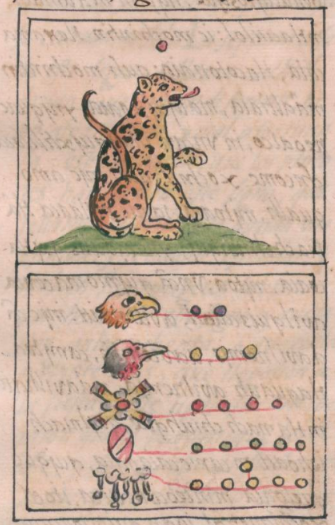Eyi Tzopilotl (FCbk4f6v)
This colorful painting of a simplex glyph-plus-notation has as its focus the date Eyi Tzopilotl ("Three Turkey Vulture," or 3-Turkey Vulture), in the religious divinatory calendar called the tonalpohualli. The glyph is a profile of the head of a turkey vulture (tzopilotl), facing toward the viewer's right. Its visible eye is open, but its beak is closed. The coloring of the feathers is white to dark grey, and with red on the face and neck. To the right of the turkey vulture's head and connected to it by a red line is the notation for the number three (eyi), consisting of a row of three small circles painted yellow. The entire date is boxed, which is often the case with dates, even if there is a shared purpose of setting the glyph off from the text on this pages, as can be seen in the contextualizing image.
Stephanie Wood
1577
Jeff Haskett-Wood
tonalpohualli, calendarios, fechas, días, animales, pájaros, feathers, plumas

eyi, three, https://nahuatl.wired-humanities.org/content/eyi
tzopilo(tl), turkey vulture, https://nahuatl.wired-humanities.org/content/tzopilotl
Tres Zopilote, o 3-Zopilote
Stephanie Wood
Library of Congress, https://www.loc.gov/resource/gdcwdl.wdl_10615/?sp=14&st=image
The Library of Congress is unaware of any copyright or other restrictions in the World Digital Library Collection. Absent any such restrictions, these materials are free to use and reuse. Researchers are encouraged to review the source information attached to each item. If you do publish anything from this database, please cite the Visual Lexicon of Aztec Hieroglyphs.



